Payot
In November, 1927, the N. G. Payot et Y. Beaumevieille S.A.R.L. was established in Paris (capital ₣1 million). I know next to nothing of Yvonne Beaumevieille, and verifiable information about the origins and the activities of Dr. N. G. Payot, before 1927 are also very thin.
Nadia Payot
Dr. N. G. Payot is reported to have been born Nadia (Nadja, Nadine) Grégoire Rakhat (Rachat/Rachatt) in 1887, in Odessa, Russia, the daughter of Grigorij and Paulina Rakhat. She left Russia for Switzerland – possibly in 1907 – where she studied medicine at the Université de Lausanne. Her 1912 graduation as a doctor is the first record I have for her.
In 1913, Nadia married Edmond-Albert Payot, an engineering graduate from the Ecole Polytechnique de Lausanne. He had been working on the Lötschberg Tunnel, which was used to lay a railway connecting the Swiss towns of Spiez and Brig. It was completed in June, 1913, just before his marriage to Nadia. The newlyweds left for Argentina where Edmond took up a position working on the Gran Chaco railway while, I assume, Nadia practiced as a doctor. The couple remained in South America until December, 1917 when they sailed on the S.S. Vestres from Buenos Aires to New York.
In the United States, Edmond took up a position with J. G. White Engineering, a large New York corporation while, according to one report, Nadia studied at the Polyclinic Hospital at 341-351 West 50th Street. In 1919, they returned to Paris where Edmond was employed on an assortment of public projects before helping Nadia expand her business. Nadia’s activities between 1919 and 1927 are unknown to me. There is an unconfirmed report that she set up a cosmetic laboratory to grind powders in a house at 6 Rue Cuny, Bois-Colombes in 1920. If true, it suggests that she may have been involved in the beauty business well before 1927 but there is no evidence to confirm it.
Salon
The N. G. Payot et Y. Beaumevieille S.A.R.L was based at 12 Rue Richepanse, Paris. The establishment, which included a sales room, offices and treatment rooms, was inaugurated on Sunday 25th March, 1928 with additional facilities opened at 10 Rue Richepanse in May, 1929.
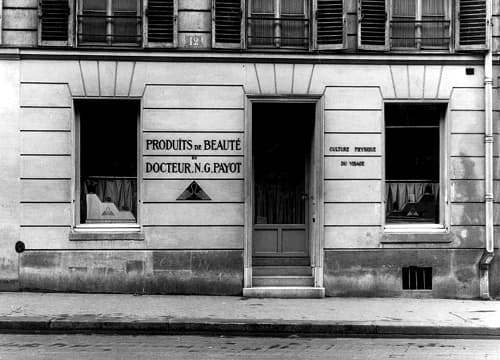
Above: c.1928 Payot salon at 12 Rue Richepanse, Paris, renamed the Rue de Chevalier-de-Saint-George in 2001 (Smithsonian).
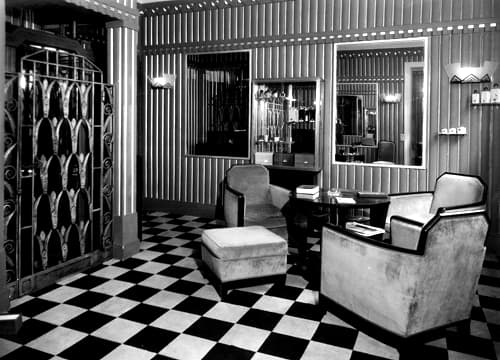
Above: c.1928 Reception room at the Payot salon. Clients would take the lift on the left to the treatment rooms upstairs (Smithsonian).
Photographs indicate that Nadia had her own office and probably did consultations there. Her role in the beauty side of the business would have been to act as its spokesperson, and to develop and give credibility to the salon’s products and treatments.
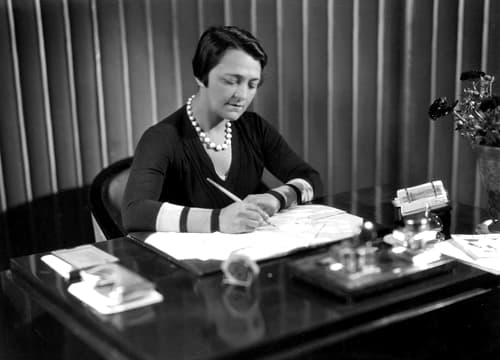
Above: c.1928 Payot in her office in Rue Richepanse.
Although Nadia was photographed in the treatment rooms, it seems likely that the day-to-day operation of the salon was left to Yvonne Beaumevieille, the salon directrice. Her social connections would have also helped bring in clients.
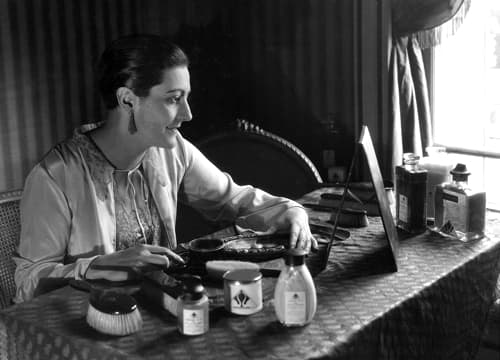
Above: c.1928 This may be the directrice of the Payot salon, Yvonne Beaumevieille. She partnered with Dr. N. G. Payot and others to establish the business (Smithsonian).
In 1933, the company was renamed the Laboratoire du Docteur N.-G. Payot. This does not appear to have been due to a falling out between Nadia and Yvonne as both women were at the inauguration ceremony in December, 1935 in the company’s new, larger quarters at 10 Rue de Castiglione.
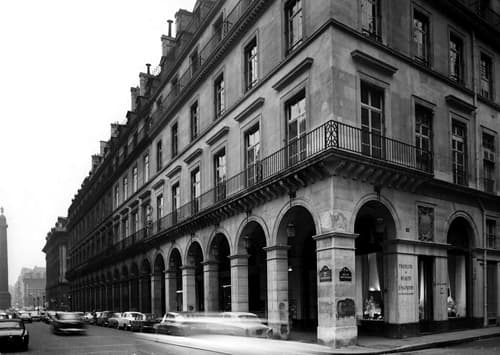
Above: Institut du Dr. N. G. Payot at 10 Rue de Castiglione.
Payot products and methods were soon adopted by others. Maria Hörnés in London was using them in 1928 and, by 1932, Payot cosmetics and routines could be found in salons in places such as Nantes, Biarritz, Cherbourg, and Angers.
Culture physique du visage
On the right-hand side of the entrance to the salon at 12 Rue Richepanse was the sign ‘Culture Physique du Visage’, a phrase that was also used on almost all Payot advertising right through until the Second World War. Translated as ‘Physical Culture for the Face’ it was a statement of the underlying ethos of the Payot method, namely that a youthful appearance could only be maintained if the facial muscles remained firm. A daily, two-minute program of ‘facial gymnastics’ designed by Nadia Payot would tone and firm the muscles, activate cell renewal and promote circulation, all activities that would improve the facial contours and lead to a younger-looking face.
Nadia supposedly developed her idea of facial exercises after meeting the prima ballerina Anna Pavlova [1881-1931] during her time in New York. She attributed Pavola’s youthful-looking body to constant activity and thought that exercising the facial muscles would do the same for the face.
Dr Payot.
“Whereas the body is never immobile, the face is always motionless. How can we be astonished, then, that wrinkles make their appearance, that the skin degenerates, becomes flabby and colourless? The circulation of the blood is defective, and therefore the muscles deteriorate.” Consequently, facial massage every day is indispensable. Evening is the best time to carry out this duty, but attend to it also in the morning, if you have the time.(Hairdresser and Beauty Trade, 1935)
The exercises Nadia developed could be used by older women to improve the signs of ageing but, working on the principle that it is better to ‘prevent than cure’, younger women were encouraged to use them to help keep their face firm and to stop the ‘sagging’ that led to wrinkles.
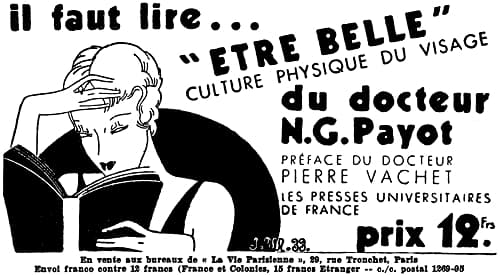
Above: 1934 Être Belle. First published in 1933, it outlined many of Nadia’s ideas on maintaining a youthful appearance.
The program of ‘facial gymnastics’ Nadia suggested included a set of targeted muscle contractions combined with a massage routine, both ideas that had been around since the early twentieth century if not before.
See also: Massage Wrinkles and Double Chins and Facial Gymnastics
Removing harmful ‘toxins’ was also critical to the Payot plan for maintaining a youthful look. A good diet was important, as were the muscle movements, that stimulated the circulation and reduced ‘congestion’. However, a suitable cleanser was needed to remove any barriers that might prevent the skin from ‘breathing’ or stop it from eliminating accumulated toxins. This was to be done with a cleansing cream or lotion suited to the client’s skin type rather than soap and water. Nadia generally disapproved of soap.
See also: Skin Breathing
A woman coming to the salon for the first time would have her skin diagnosed before being taken by lift to a treatment room. There she would have her face cleansed and massaged before being instructed in the massage routine to be used at home. This would be followed by a spray and light bath using either red or blue light depending on the condition of her skin, another common treatment of the time.
See also: Red Light, Blue Light
The home massage treatment she was taught worked on the cheek muscles, the naso-labial fold, the area around the eyes, and the forehead, all areas where lines could appear. The cheek muscles (masseter) were a particular focus and Nadia often recommended that women chew slowly three times a day to improve them.
Facial routine
The massage routine suggested by Payot would only be effective if it took place after a careful cleansing. Nadia thought that the evening routine was the most important. If the skin was cleansed and exercised before sleep the toxins that had accumulated during the day would be ‘flushed’ out allowing the skin to rest and firm up overnight. If this was not done, the toxins and impurities would cause the skin to tire and loosen and rest would not be beneficial.
The 1930 Payot facial routine was as follows:
Evening: The face was first cleansed with a piece of cotton soaked in a Payot astringent or tonic – Lotion No. 2 (tonic for dry skin) or Lotion No. 6 (astringent for greasy skin). Then Payot Crème No. 1, containing camphor, almond oil and mint, was spread over the face followed by the massage movements:
1. Pat all over the face.
2. Massage in a circle in front of the ears, 15 times.
3. Massage in circles around the eyes towards the nose.
4. Massage the forehead in circles.
5. Massage the nose in circles.
6. Open the mouth and then massage with 3 fingers going from chin to cheekbones and ears.
7. Massage the neck in circles and up and down following the muscles.
The cream was left on for 10 minutes but then removed. Nadia considered it unadvisable for it to be left on overnight as it would ‘hinder the ability of the skin to breathe’.
Morning: Wipe the face with Lotion No. 1 and then pinch the cheeks from the nose towards the ears.
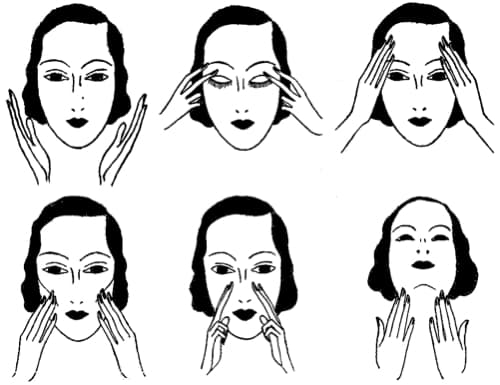
Above: Facial massage movements.
By 1933, the massage routine had undergone some modifications and was now:
1. Pat all over the face with the fingertips, to activate the circulation.
2. Massage the masseter (cheek) muscle in circles, about fifteen times, using two fingers to work the muscle well.
3. Massage in circles around the eyes, starting from the base of the nose and following the brow bone.
4. Massage in circles, on both sides of the wings of the nose.
5. With two fingers, massage the forehead and temples in circles over the entire surface, using four or five movements in each position.
6. Open the mouth in the round, then, with three fingers of each hand, slide them up both sides up to the cheekbones towards the ears.
7. Using the whole hand, massage the neck driving the blood up and down towards the heart.
8. Pat the underside of the chin vigorously with the back of the fingers.
Nadia distinguished between the ‘passive gymnastics’ of the massage movements given above and ‘active gymnastics’, which employed a set of exercises to contract the facial muscles. Active gymnastics, which included chewing, worked on the deeper muscles of the face while the passive massage movements were used to treat muscles that were more superficial. However, it seems difficult to reconcile this distinction with the recommended practices.
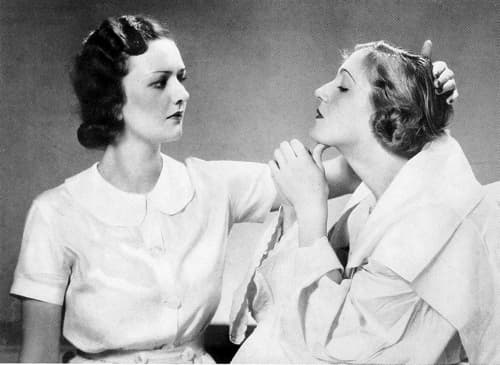
Above: 1936 A woman getting instructions on the active facial gymnastic movements using the fingers to push the chin back while contracting the neck muscles.
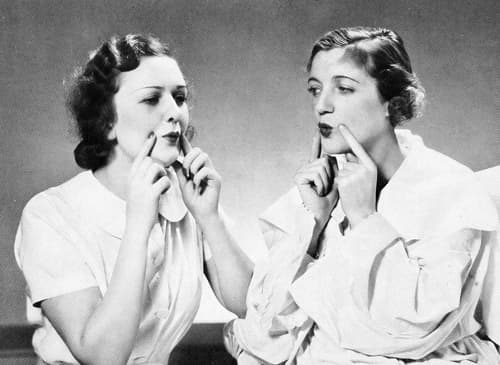
Above: 1936 A woman getting instructions on active facial gymnastic movements pronouncing the letters U and X very vigorously.
Like the massage movements, the ‘active gymnastic’ routine changed over the years. By 1954, it included four active gymnastic movements, two for the muscles of the face and two for the muscles of the neck. These complemented the seven passive massage movements, five for the face and two for the neck.
The four active gymnastic movements were:
1. Forcefully pronounce the letters U, X, by very vigorously contracting the jaw muscles.
2. After pressing two fingers on the temples to maintain the skin, open and close the eyes forcefully a dozen times in a row, to work the muscles of the eyelids.
3. With the back of both hands, slowly push the chin back, while contracting the muscles of the neck.
4. After tipping the head back and putting the hand on the back of the neck, pull hard on the neck muscles.
Other treatments
When the company moved to larger quarters at 10 Rue de Castiglione in 1935, the additional space enabled the installation of a spa treatment room where clients could get a hydro-massage.
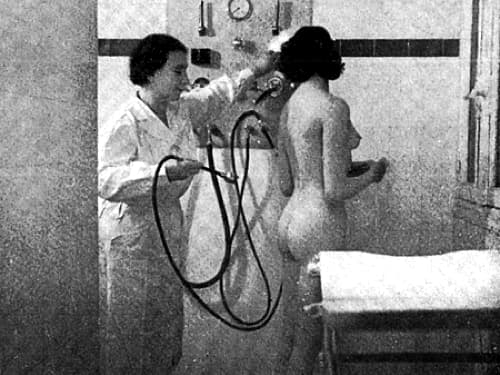
Above: Payot spa treatment.
A cold shower was part of Nadia’s recommended treatment for improving the bust. The daily cold shower was to be followed by two physical training exercises:
1. First while standing in front of a mirror, women were asked to their armes forward and, while breathing deeply to cross their arms making the letter X and then repeat this manoeuvre seven times.
2. Then, extending their arms as much as possible without bending them to tuck in the scapula muscle.
Having completed the exercises they were then to shower their chest in cold water for three or five minutes before rubbing in a special lotion based on iodine and witch hazel.
A number of ‘energising tables’ were also installed in the new facilities. Imported from the United States they vibrated the whole body which supposedly relaxed and energised the body by deeply ‘massaging’ the internal organs.

Above: 1938 Vibrating table. Vibrating tables were later used by Stauffer and Slenderella in weight-control programs.
Acne treatments
Nadia Payot had consulting rooms at both Rue Richepanse and Rue de Castiglione and the Institut du Dr. N. G. Payot had treatments for a range of more serious skin conditions including acne.
Nadia subscribed to the idea that acne resulted from poor food, or disorders of the digestive, reproductive or circulatory systems so her treatments began with a detoxification diet that avoided alcohol, fresh bread and over eating.
The salon treatments for acne appear to follow the practice laid down by the french dermatologist, Dr. Lucien Jacquet [1860-1914]. Pustules were brought to the surface with deep massage movements and were then lanced, a treatment that would not be recommended today. Alcohol, ether, acetone and sulphur were also used as were carbonic gas sprays and direct high-frequency treatments.
See also: Carbonic Gas Sprays and High Frequency
Payot’s Lotion No. 5 for acne formed part of the original Payot range. At some stage, probably 1947, Payot introduced two new acne products, Lotion Spéciale (Contre Acné) which contained resorcinol and Pâte Contre Acné. I assume the Pâte Contre Acné was a paste version of the Lotion Spéciale so would also have contained resorcinol, still used today in some acne treatments.
Another anti-acne product developed by Payot in this period was Pâte Grise which, as its name suggests, was gray in colour. This was due to the presence of ichthammol, a black extract of shale oil tar that is rich in sulphur. Other active ingredients included zinc oxide still used today to heal wounds. Almond oil and talc were also present, presumably to make up the bulk of the paste. Pâte Grise was to be applied and left on overnight in conjunction with daily treatments with Lotion No. 5 alternated with Lotion Special (Contre Acné).
D’Assailly (1958) also reports that Nadia installed an X-ray machine in the Institut and hired a technician to operate it after she became convinced that only X-ray treatments could produce a lasting cure for acne. In the past, X-rays were used for a variety of skin complaints often resulting in the production of cancers in the longer term.
See also: X-rays and Hair Removal
Skin-care products
Nadia preferred to think of her skin-care products as chimiothérapie (chemotherapy) rather than mere cosmetics. They worked in tandem with the massage movements but were less effective without them.
Hygiene was an important part of maintaining a healthy skin but, as mentioned previously, Nadia was not a believer in cleansing with soap and water unless a medicated soap was required. All of the Payot skin-care routines therefore began with an astringent, toner or cleanser. These removed any barriers to the healthy functioning of the skin with the particular product selected according to skin type – dry, normal or oil. Payot also sold a skin food to provide nourishment, Payot Crème No. 1.
Lotion No. 1: “Based on camphor and almonds. Tonic, firms the epidermis. For dry, oily, and normal skin.”
Lotion No. 2: “To tighten pores and cleanse the epidermis.”
Lotion No. 3: “Tonic, firms the epidermis. For delicate skin.”
Lotion No. 4: “To tighten pores and purify the epidermis.”
Lotion No. 6: “Astringent and refreshing.”
Crème No 1: “Cleanses and nourishes the skin. For dry, oily, and normal skin.”
See also: Skin Tonics, Astringents and Toners and Skin Foods
Also included in the skin-care range were a number of products for specific skin-care problems such as redness, shine, acne, freckles and blackheads. Gelée Camphrée for oily skin and blackheads contained camphor and iodine. Camphor, which has anti-inflammatory and antimicrobial properties, was also used in Lotion No. 1 and may have also been included in Lotion No. 5 for acne, and Crème Médicale No. 2 for redness, irritation and sunburn. The Payot range also contained a medicated soap, bath salts, a massage lotion containing witch hazel, a hand cream made with lemon juice and almond oil, and a ‘fat dissolver’.
Lotion No. 5: “For acne.”
Crème Médicale No. 2: “For redness, irritation and sunburn.”
Crème No. 4 (Gelée Camphrée): “For oily skin and blackheads.”
Crème No. 7: “For nose shine and to hide spots.”
Crème No. 8: “For freckles and yellow spots.”
Crème D’Amandes: “Completes the action of Lotion No. 4.”
Friction Dorée: “For the body.”
Anti-sudoral: “For perspiration.”
Gelée Amaigrissante: “For adiposity.”
Crème No 6: “[S]oftening for the hands.”
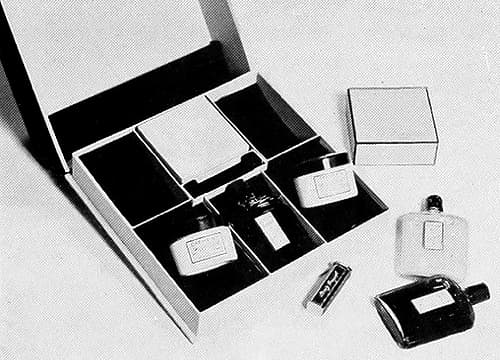
Above: 1934 Payot Coffret de Traitement.
Also see the booklet: Culture Physique du Visage (c.1930)
In 1933, Payot added Golden Rays, following with Golden Rays B in 1935. Both products were designed with sun exposure when outdoors in mind. Golden Rays was described as a sun protectant but was used after a day out, not before. It is believed to have contained alum and rosewater. It was to be massaged into the skin at night after the skin was cleansed and then wiped over the face again in the morning using a piece of cotton.
Golden Rays B, made with a base of olive oil, was applied before sunbathing to help achieve a fashionable suntan. Payot also suggested that some women might also find it useful as a base for make-up.
Two other skin-care cosmetics from this period worth noting are Crème Embryonnaire (1938) and Crème Nutricia (1941). It is possible that Payot also sold a Crème Hormone during the 1930s but the evidence is not definitive. All these products mark the introduction of what can be loosely called ‘biologicals’ into Payot’s skin-care range, a process that will expand after the Second World War.
Payot may have been the first company to use embryo extracts in a cosmetic. Crème Embryonnaire was said to promote skin renewal and was recommended for ‘fragile, tired skins, liable to wrinkle or premature drying’. It removed the dead cells that could potentially ‘suffocate’ the skin and also stimulated the growth of new cells.
See also: Embryo Extracts
Crème Embryonnaire was also used as an anti-wrinkle and rejuvenating cream around the eyes, joining Lotion Yeux Blanche, used for decongestion and Lotion Bleue, made with witch hazel and borax as a remedy for puffiness; these other eye products added by 1947.
Crème Nutricia was a vitamin cream contained vitamins A (retinol) and F (linoleic acid), the later now considered to be an essential fatty acid rather than a vitamin. Both ingredients are fat-soluble and have a good shelf-life so were relatively easy to incorporate into a cosmetic.
See also: Vitamin Creams.
Make-up
The initial Payot make-up range covered most areas – powder, rouge, eye and lip make-up, and nail polish – in a limited range of shades. I know very little about the range. Crème No. 2 could be used as a powder base as well as a night cream which suggests that it might have been ‘heavier’ than Crème No. 3 which may have been a type of vanishing cream. It also seems likely that Baume No. 20 was a type of wet white. The face powder sold by Payot at this time was made with sweet potato so was not a Poudre de Riz.
See also: Vanishing Creams, Liquid Face Powders and Poudre de Riz
No nail polish shades are mentioned so it may have only come in a clear or a pale pink (natural) shade.
Crème No. 3: “To fix the powder.”
Baume No. 20: “Instantly whitens the neckline and hands.”
Poudre: (Face Powder) Shades: Rachel, Ocre, Rose-Ocre, Ocre Rosé, Ocre Foncé, Péche, Apricot, and Naturalle.
Pastel Pour Les Joules: (Compressed Rouge) Shades: Framboise, Mandarine, and Brunette.
Rouge Pour Les Joules: (Liquid Rouge) Shades: Mandarine, and Carmin.
Pastel Pour Les Yeux: (Powder Eyeshadow) Shades: Diamantine, Blond, Chatain, Brun, and Bleu.
Gras Pour Paupières: (Cream Eyeshadow) Shades: Chatain, and Bleu.
Produit Pour Les Cils: (Mascara) Shades: Noir, Chatain, Bleu, and Vert.
Crayon Noir: (Eyebrow pencil).
Cire Pour Les Lèvres: (Lip rouge) Shades: Carmin, and Mandarine.
Crayon Rouge: (Lipliner).
Vernis Pour Les Ongles et Dissolvant: (Nail Polish and Remover).
In 1935, Payot introduced Le Rouge 1935, an indelible lipstick containing vitamins, in Mandarine, Lumière, Électric, and Grenat shades. This may have been Payot’s first lipstick. Two years later the company added a foundation (fond de teint) in five graduated shades – Clair, Pêche, Côte d’Azure, Mauresque, and Tahiti – with face powders to match.

Above: 1935 Payot Rouge 1935.
War
As far as I can tell the Institut at Rue de Castiglione remained open during the occupation but, like other companies, it would have had increasing difficult in accessing the raw materials needed to make its cosmetics. The war also cut Payot off from its overseas markets and many of these took time to reestablish after the war. For example, Payot cosmetics would not reappear in Britain until 1952.
Post-war
In 1947, the company moved its manufacturing plant and laboratories to 8 Rue Cuny, Bois-Colombes, began updating its product line, upgraded its product packaging, and set about recapturing and expanding its market base in France and elsewhere.
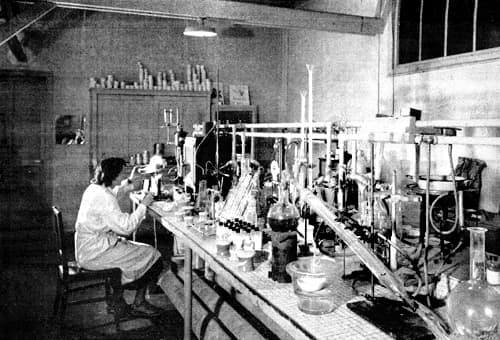
Above: 1953 A Payot laboratory at Bois-Colombes.
The general manager of the company, Edmond Payot, continued to control the development of the company and its expending international business in Switzerland, Belgium, the Scandinavian countries, Spain, Italy, Britain and Brazil until he became gravely ill and died in 1954.
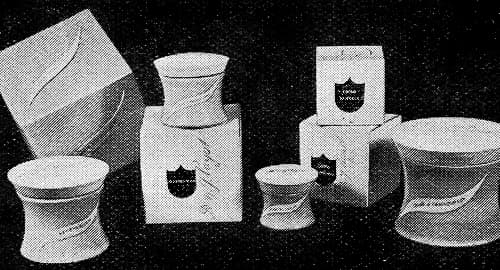
Above: 1952 Payot cosmetics in new packaging.
Facial gymnastics continued to be central to Payot skin routines but the company also developed new skin-care and make-up ranges.
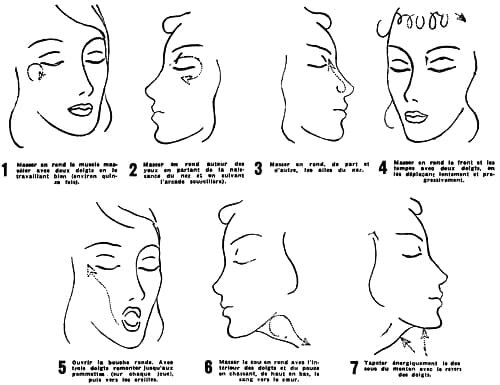
Above: 1947 Payot massage routine.
Skin-care
Most of the products available before the war continued to be sold in after 1945. Included in the list of preparations available in 1947 were: tonics (Lotion No 1, and Lotion No 3); astringents (Lotion No 2, Lotion No. 6 and Gelée Camphreé); Acne treatments (Lotion No. 5, and Lotion Speciale, and Pête Contre Acné); Golden Rays and Golden Rays B, massage creams (Crème No. 1 and Crème No. 2); a hand cream (Crème No. 6); day creams (Crème Amandes, and Crème Framoise); and masks (Masque Jeunesse, Masque Irradié and Masque Rose). Payot also sold an assortment of hair preparations and a depilatory (Cire Dépilatoire) in their inventory.
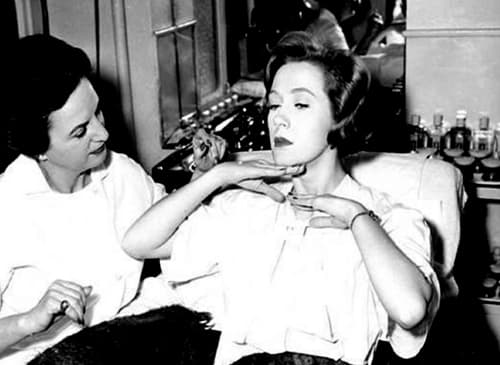
Above: Woman getting instructions on the Payot massage movements.
Most of the new skin-care creams and lotions added by Payot between 1945 and 1960 were ‘biologicals’ but there were a few other entries including the previously mentioned Pâte Gris (1947) and Maskoderm (1953), a pink, creamy mask for all skin types. Said to activate the circulation, firm muscles, refine the texture of the skin, and enliven the complexion, it appears to have relied on astringents for its effectiveness.
Biologicals
Payot had introduced a number of skin-care cosmetics with biological additives in the period leading up to 1941 including the previously noted Crème Embryonnaire (1938) containing embyro extracts, and Crème Nutricia (1941). A Crème Hormone was also in the inventory no later than 1947.
In 1948, Payot added Crème Règènoderm, and followed later in the year with Règenoserum. When these cosmetics were introduced into North America in the 1950s they were sold as Rege-O-Serum and Rege-O-Derm to avoid misbranding problems with the American Food and Drug Authority (FDA).
Crème Règènoderm combined all of Payot’s previously used biologicals – vitamins, hormones and embryonic extracts – in the one product. When first introduced, Payot suggested that it be used in the evening massage routine for six to ten days and then on alternate nights with Crème Embryonnaire. Another suggested treatment plan was to cycle Crème Nutricia for three successive nights, then Crème Embryonnaire for a further three nights, then Crème Règènoderm for the next night or two. If used alone, Crème Règènoderm was generally recommended for normal or oily skins and Crème Embryonnaire for dry skin types.
Règenoserum was a hormone mask packaged in individual ampules. These were sold in boxes of ten to be applied for 10, 20 or 30 days depending on the condition of the skin. Like Crème Embryonnaire it was an anti-wrinkle treatment, generally recommended to be used with Crème Embryonnaire on skins that needed an extra boost as, for example, during the summer months.
Payot updated the formula for Crème Embryonnaire and Crème Règènoderm in 1954 and both products were now listed as U.P. (Ultra-Pénétrantes). They were considered to be more effective than the older formulations as they now penetrated deeper into the skin.
In 1957, Payot added plant extracts to three pre-existing products – Golden Rays, Tonique Lotion No. 1, and Crème Nutricia – which now had ‘à l’Hydro-Sève’ added to their name. The plant extracts were described as the ‘sap of young living plants’ which were said to also have a stimulating effect on human tissue. In a sense these extracts were plant versions of the embryo extracts, a form of phytoembryotherapy or gemmotherapy. The Crème Nutricia à l’Hydro-Sève with its additional vitamins was still credited with being nourishing and hydrating as well.
By 1958, the ‘à l’Hydro-Sève’ was being downplayed and the three products were promoted more prominently as ‘stimulating’. When used together they were said to be capable of rejuvenating and moisturising dry, tired skin with Golden Rays Stimulation for cleansing, Tonique Stimulation No. 1 for toning, and Crème Nutricia Stimulation for nourishing and moisturising. A typical Payot morning routine using these three products would be as follows:
Apply Golden Rays Stimulation, before splashing the face with hot and cold water. After this, apply Tonique Stimulation No. 1 using a cotton pad soaked in this toner. Then, after applying Crème Nutricia Stimulation, pinch the face to stimulate the circulation.
Payot’s last new biological additive of the 1950s was amniotic extract. Regarded as suitable for all skin types, the range began in 1959 with a skin cream and tonic, Crème Amnioderm and Hydramniotique respectively, followed Masque Amnioderm later in the year, with Emulsion Amnioderm, a body cream, added in 1960.
See also: Placental Creams and Serums
Payot continued to add new biologicals in the 1960s with the addition of Crème Hemera (1964) which was recommended as a night cream or as a powder base during the day. The ‘active ingredient’ this time was ribonucleic acid (RNA) but it also contained ‘biological oils’ and witch hazel. Although RNA is ‘essential for the activity of the cell during its life cycle’ like most of the other biological materials Payot added to its skin creams and lotions over the years it was not going to reverse the signs of ageing.
Moisturisers
A number of Payot skin-care cosmetics were described as hydrating in the 1950s before the company added Crème Hydriane in 1961, described as bi-hydrating due to the presence of both sage and watermelon. The lotion was the first product produced by Payot where hydration was the main feature so I think this can be regarded as its first moisturiser. It could be used either as a day cream or under make-up or at night.
Skin-care routine
Despite the addition of new products, the Payot skin-care routine used in the early 1960s remained largely faithful to the principles first laid down in 1928. It was as follows:
Evening:
1. Remove make-up with Golden Rays Stimulation or Crème de Démaquiller followed by a tonic – Lotion No. 2 for dry skin or lotion No. 6 for oily skin.
2. Then apply a nourishing skin cream – either Crème Nutricia Stimulation for normal skin, Crème Embryonnaire for dry skin; Crème Regenoderm for oily, dull or withered skin, or Crème Amnioderm cream for all skin types – along with the Payot massage movements. Then let the skin rest for the night.
3. Try to put the worries of the day aside and get a good night’s sleep.
Morning:
1. Alternate hot and cold water over Golden Rays Stimulation, then tone the skin and facial muscles with Tonic Stimulation No. 1 or Hydramniotique.
2. Then moisturise the face with Crème Hydriane and apply make-up.
Cellulite
Payot salon treatments for cellulite became prominent in the 1950s. They followed similar patterns to those offered by other establishments, the main innovation being the use of an interferential machine – mostly likely a Nemectron – to electrically stimulate muscle contractions.
See also: Interferential Treatments
The treatment began with a light, manual massage performed under a bath of infra-red light to warm the body and activate the blood circulation.
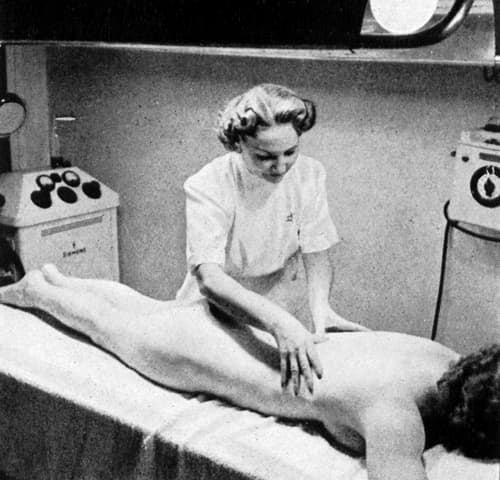
Above: 1955 Cellulite treatment.
This was followed by a deeper massage of the hips, buttocks and waist, then a 20-minute interferential treatment to electrically contract muscles in areas where cellulite was developing. The next step was a vacuum-suction treatment using different-sized cups depending on the part of the body treated. Smaller cups were used on the stomach and waist, larger cups to ‘reposition’ the breasts.
See also: Vacuum Suction
Arms and shoulders were treated manually by massaging them with a slimming cream. The treatment was concluded with a needle shower to clean and refresh the skin.
Make-up
Payot also added biologicals to its make-up with the introduction of the Ligne Germinal, sometimes referred to as Ligne Germinal 1955. Despite the name, the range began in 1952 with the debut of the Germinal lipstick containing Germ’X, a wheatgerm extract, along with a skin protectant, benzoin. Germinal came in Tenace, Onctuex, Frais, Luminex, and Brilliant shades with Rose Tendre, Rouge Ardent, and Castiglione shades added in 1953. Additional lipstick shades that I know of added after this were: Bois-de-Rose, Lumière d’Eté (1954); Rose Tremiere, Corail Rouge, Soleil, Cornaline, Montmorency and Coquelicot (1955); Eglantine (1957); Incarnat, Grenade, Geranium, and Malmaison (1958); Amboise, Chinon, Langeais, Blois, Royal Or, Royal Argent, and Royal Blanc (1959); Luynes, and Plessis (1960); Piment Fort, Piment Rose, Passe Rose, and Eden Rose (1961); Ile de France, and Val de Loire (1962); Antheor, and Manosque (1963); Corfou, Rhodes, Espiegle, Joli Faon and Jeunesse (1964); and Corail Rose, and Ajonc d’Or (1966).
The second make-up item added to the Ligne Germinal was Crème Sans Risque (1953), a cream foundation in Invisible, Trianon, Versailles, and Cinema shades. This was not the only new tinted foundation in the Payot range. Payot had previously added a bronze tint to its Crème Nutricia which then became Crème Nutricia Teintée Bronzée, the older formulation now listed as Nutricia Blanche. Additional shades were them added to Nutricia Teintée, so that its shade range had increased to seven by 1954. Two other tinted foundations added during this period were Crème Satin (1958) semi-fluid foundation in six shades; and Tayane Fond de Teint (1961), a fluid foundation in Bronze, Cuivre, Soleil, Indienne, and Tzigane shades. Both of these products were sold in both jars and tubes, tubes being used more frequently to package Payot products after 1958.
As tinted foundations became more prominent in the 1950s face powders became more translucent, Payot’s version being Nimbe de Beauté (1956). It came in Bois de Rose Clair, Bose de Rose Foncé, Clair, Castiglione, Jour et Soir, Cote d’Azur, Deauville, Lumière d’été Clair, Naturelle, Precieux Beige, Precieux Rose, and Soleil shades with Persane and Perle Ochrée shades added by 1958. In 1958, Payot also added a compressed form, Nimbe de Beauté Compact. Then, in 1966, Payot released Nimbe de Beauté Speciale, a modified version of the original powder in Melissa, Cassandre, Antinéa, and Roxane shades with Dione, Elvire and Moira shades added the following year.
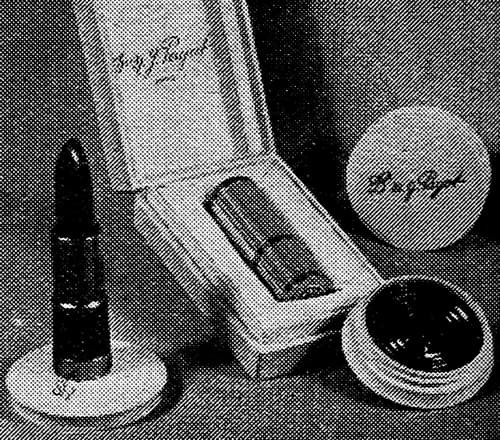
Above: 1952 Payot make-up.
Other make-up items added to the Payot make-up range included lipliner and eyeliner pencils with small sharpeners positioned in the lid. These came in Clair, Vif, and Fonceé shades for the lips, and Brun, Oris, Bleu, Noir, and Chatain shades for the eyes. The company also sold stick and compressed-powder eyeshadows and a block mascara. However, as far as I can tell, there was no automatic mascara in the range before Nadia Payot’s death in 1966 which is where my interest in the company ends.
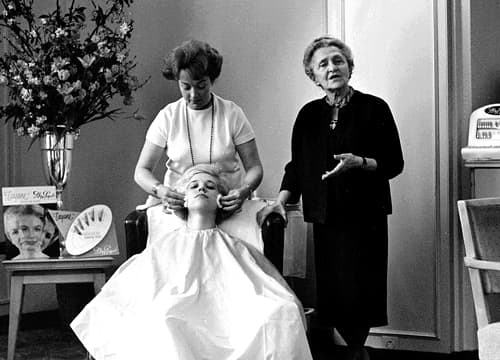
Above: 1962 Nadia Payot demonstrating at the Hôtel Carlton, Paris.
Later developments
Like many other cosmetic companies Payot got caught up in the merger and acquisition frenzy of the 1960s and 1970s. In 1972, it was bought by the American conglomerate I.T.T. (International Telephone and Telegraph) through a Swiss holding company, Cosmatex. In 1980, ownership passed to the German company Müelhens GmbH & Co. K.G. that was looking to expand its international operations. In 1994, Müelhens was bought by Wella A.G. who then sold Payot to the Spanish company Myrurgia in 1996. In 2000, Piug, a family-owned fashion and fragrance company based in Barcelona, bought Myrurgia but, in 2014, they sold Payot to LBO France, a French private equity firm founded in 1985 by Gilles Cahen-Salvador [b.1943]. LBO France are the current owners of the brand.
Timeline
| 1927 | N. G. Payot et Y. Beaumevieille S.A.R.L. established. |
| 1928 | Salon opened at 12 Rue Richepanse, Paris. Payot products sold in Britain. |
| 1929 | Salon extended to 10 Rue Richepanse. |
| 1933 | N. G. Payot et Y. Beaumevieille S.A.R.L. becomes Laboratoire du Docteur N.-G. Payot S.A. New Products: Golden Rays. |
| 1935 | Payot moves to 10 Rue de Castiglione. New Products: Golden Rays B; and Le Rouge 1935. |
| 1937 | New Products: Fond de Teint. |
| 1938 | New Products: Crème Embryonnaire. |
| 1941 | New Products: Crème Nutricia. |
| 1947 | Manufacturing plant and laboratories moved to Bois-Colombes. New Products: Pâte Grise. |
| 1948 | New Products: Crème Régénoderm; and Régenoserum. |
| 1952 | Payot reintroduced into Britain. New Products: Rouge Germinal. |
| 1953 | Payot introduced into Brazil. Laboratoire du docteur N. G. Payot, Genève, S.A. founded. (Switzerland). New Products: Maskoderm; and Sans Risque. |
| 1954 | Payot Laboratories, Inc. founded in New York. Productos del Doctor Payot (S.A.) established in Madrid. |
| 1956 | New Products: Nimbe de Beauté Poudre. |
| 1957 | Extensions completed to the factory at Bois-Colombes. |
| 1958 | New Products: Nimbe de Beauté Compact; and Crème Satin. |
| 1959 | New Products: Crème Amnioderm; Tonique Hydramniotique; and Masque Amnioderm. |
| 1960 | New Products: Emulsion Amnioderm; and Fard Satin. |
| 1961 | New Products: Crème Hydriane; and Tayane Fond de Teint. |
| 1964 | New Products: Crème Hemera. |
| 1966 | New Products: Nimbe de Beauté Speciale. |
| 1972 | Payot bought by ITT. |
| 1980 | ITT sells Payot to Müelhens. |
| 1993 | Factory at Bois-Colombes closed. |
| 1994 | Wella A.G. buys Müelhens. |
| 1996 | Wella sells Payot to Myrurgia. |
| 2000 | Piug buys Myrurgia. |
| 2014 | Puig sells Payot to LBO France. |
First Posted: 27th January 2020
Last Update: 3rd April 2023
Sources
D’Assailly, G. (1958). Fards et beauté ou l’eternal féminin. Paris: Librairie Hachette.
N. G. Payot. (c.1930). Culture physique du visage [Booklet]. FRA: Author.
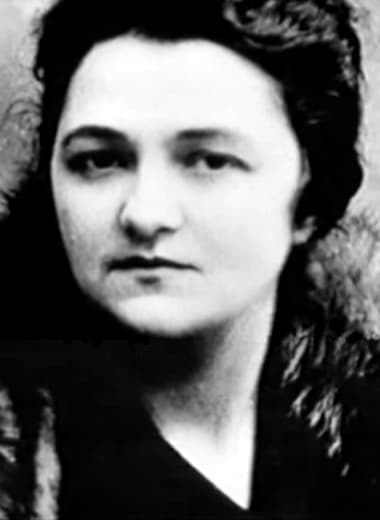
Nadia Grégoire Payot née Rakhat [1887-1966].
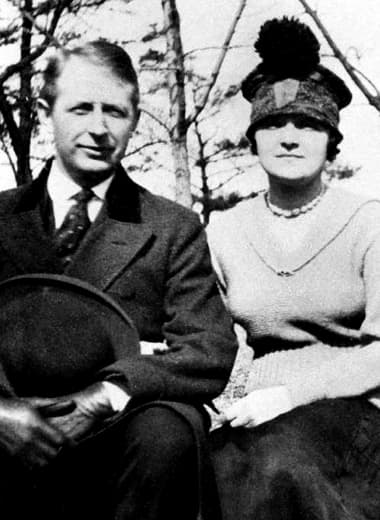
Edmond Payot [1886-1954] and Nadia Payot.
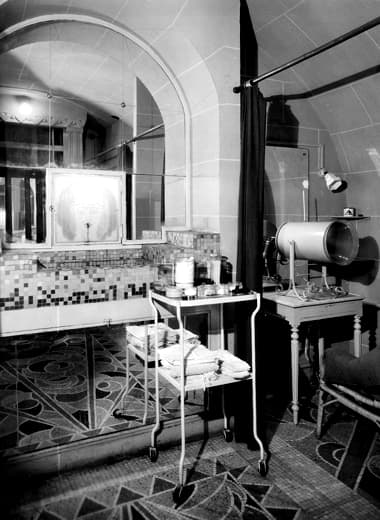
Treatment room at the Payot salon. The tubular machine on the right appears to be a Vapofor made by the Gloria Light Company. It combined steam with red or blue light (Smithsonian).
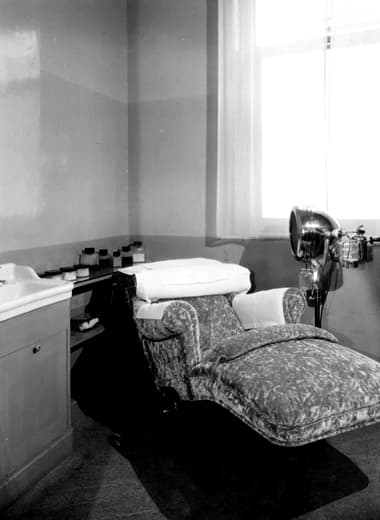
Treatment room at the Payot salon with a chaise-lounge typically used in salons the period. The machine on the right likely combines herbal sprays with a light treatment (Smithsonian).
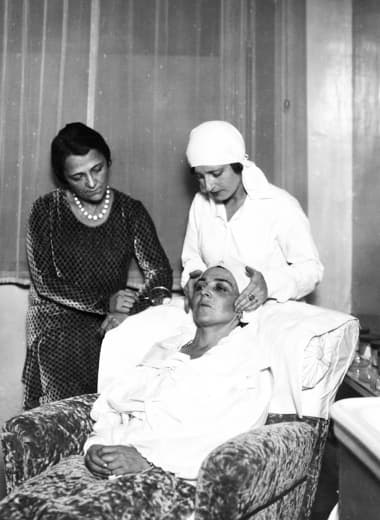
Docteur N. G. Payot with client in a treatment room.
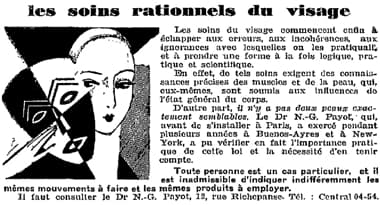
1928 N. G. Payot.
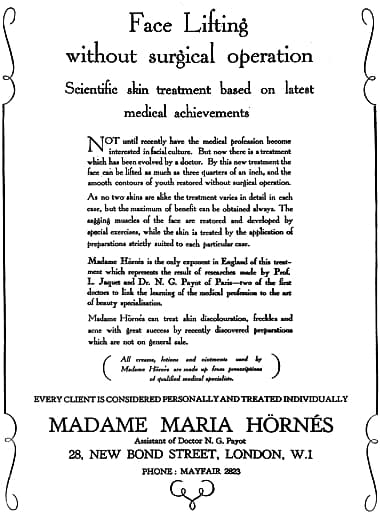
1928 Maria Hörnés salon, Bond Street, London.
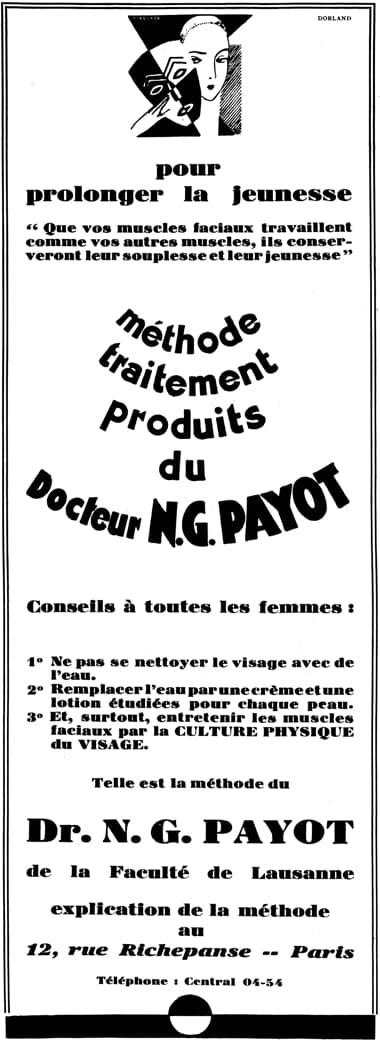
1929 N.G. Payot.
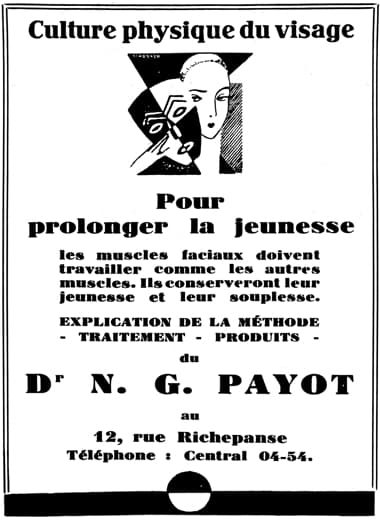
1930 N.G. Payot.
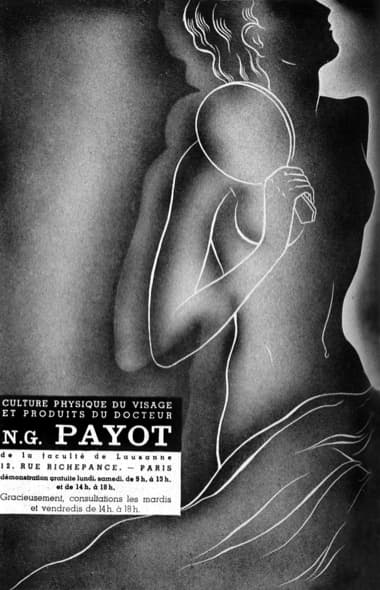
1932 N. G. Payot.
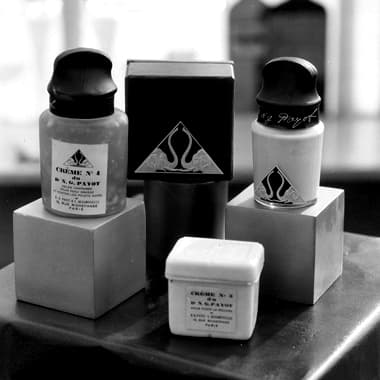
Payot Crème No. 4, Face Powder, an unknown product and Crème No. 2 (Smithsonian). The elephant logo used on early Payot cosmetics was registered in 1928.
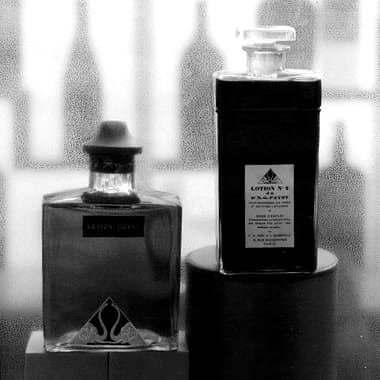
Payot Friction Dorée (massage oil) and Lotion No. 2 (astringent for dry skin) (Smithsonian).
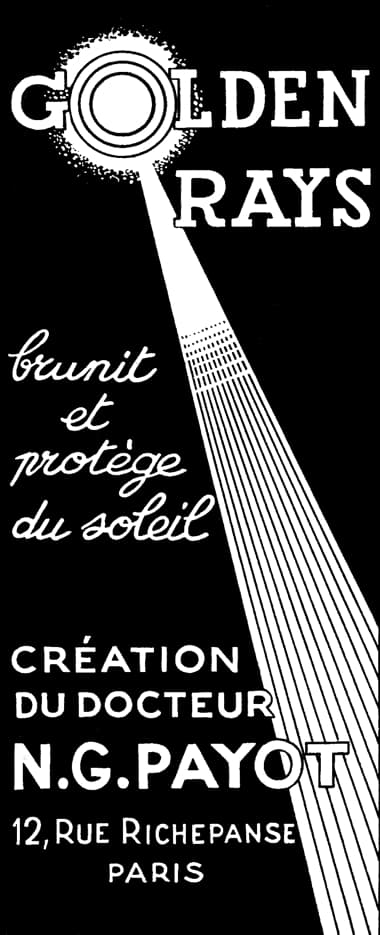
1933 Payot Golden Rays.
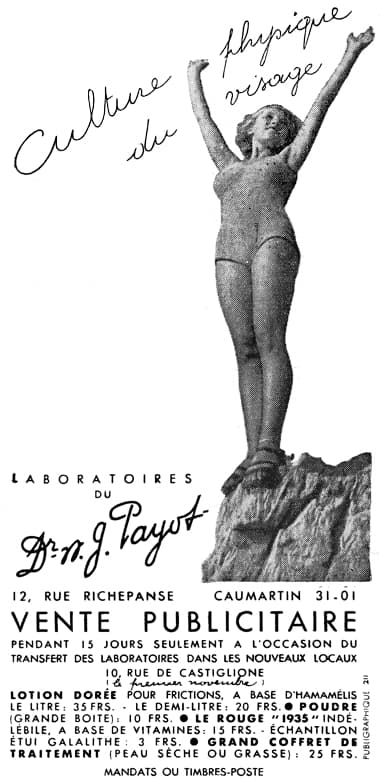
1935 Payot announcing the move from Rue Richepanse to Rue de Castiglione.
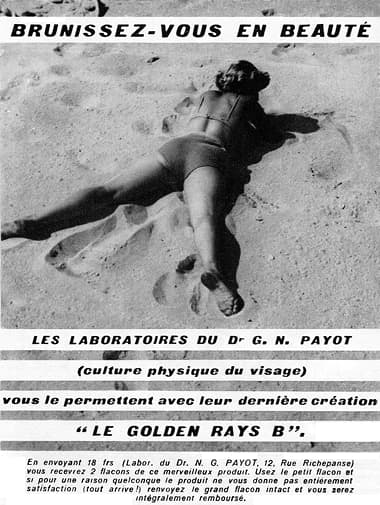
1935 Payot Golden Rays B.
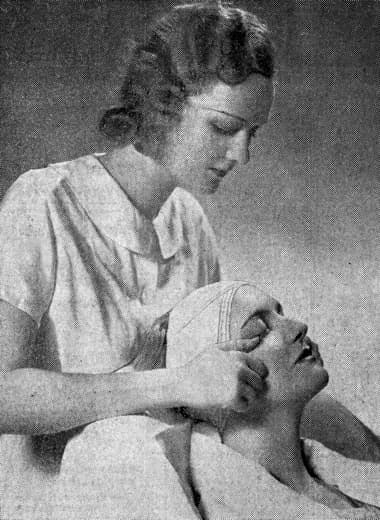
1935 The Payot facial massage routine appears to have included Jacquet movements named after their originator, Dr. Leonard Marie Lucien Jacquet. The pinching movement squeezes a small section of the skin between the thumb and forefinger while, at the same time, giving the skin a slight twisting or kneading action.
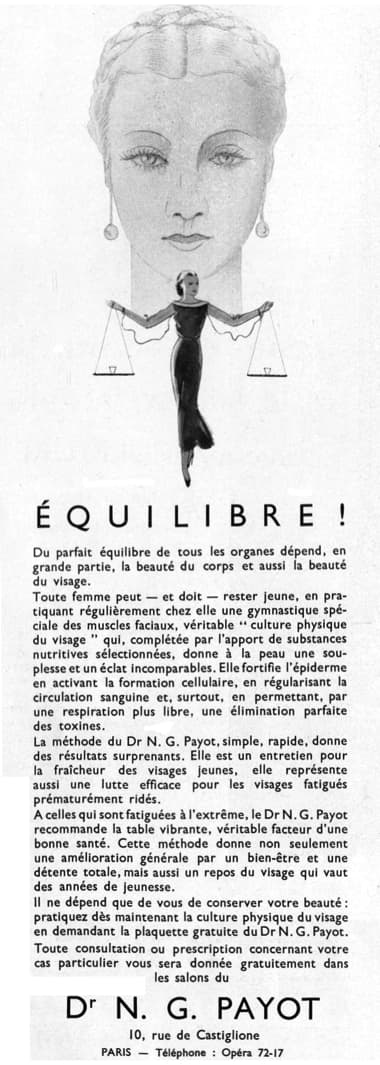
1936 Payot Équilibre.
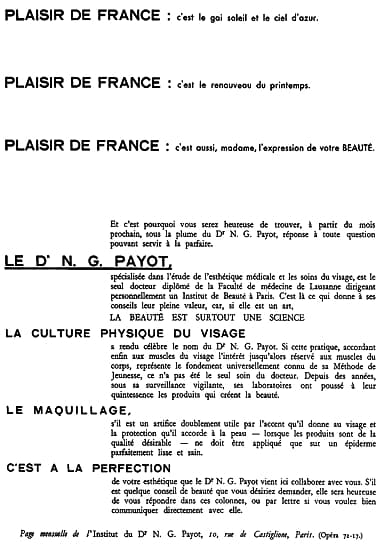
1937 N. G. Payot.
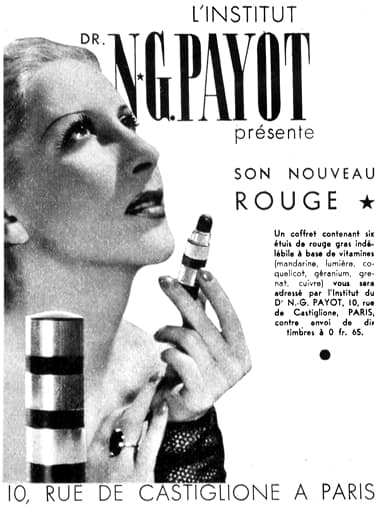
1937 N. G. Payot Rouge
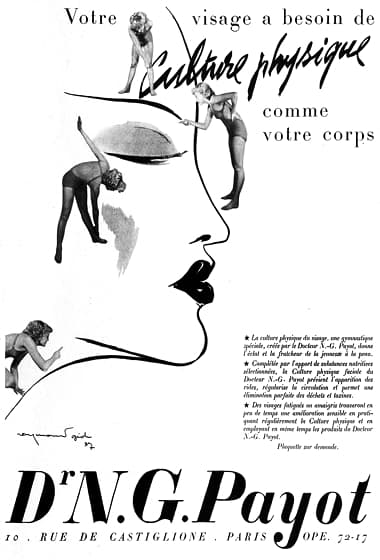
1938 N. G. Payot.
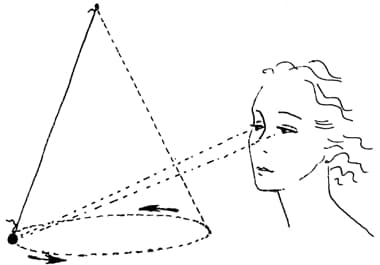
1938 Payot exercise to strengthen the eye muscles.
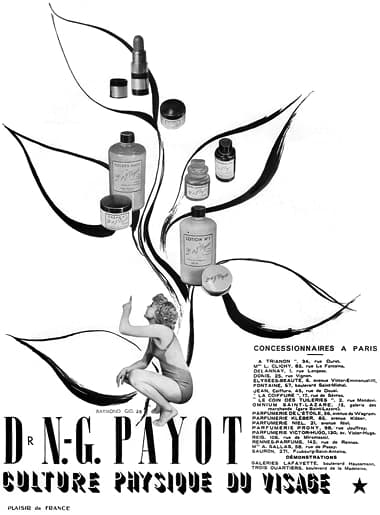
1938 N.-G. Payot. Culture Physique de Visage.
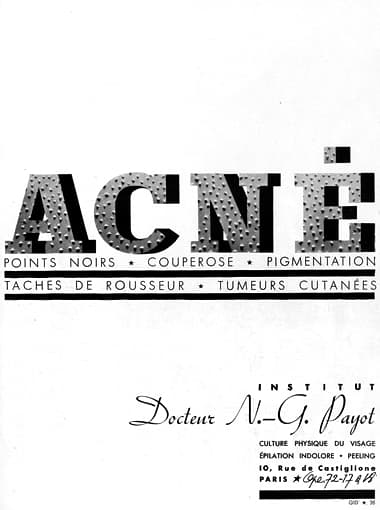
1940 Dr. N.-G. Payot offering treatments for acne, blackheads, couperose, pigmentation, freckles, and skin cancers as well as permanent hair removal and skin peeling.
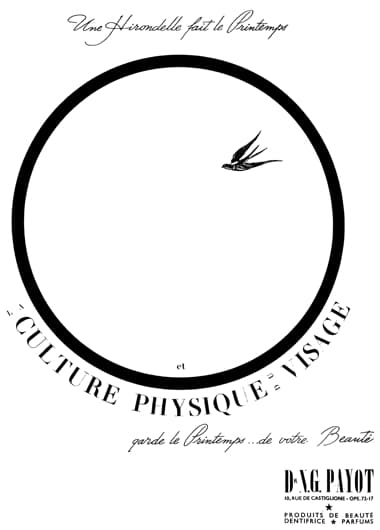
1941 N. G. Payot.
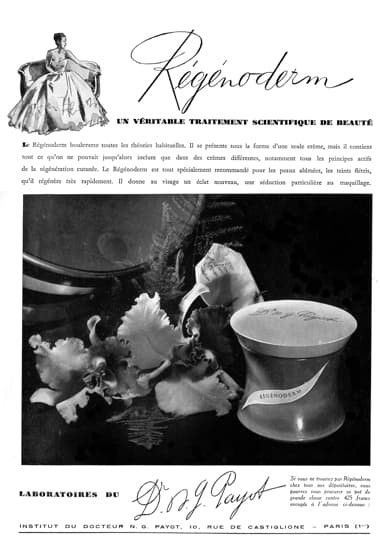
1948 Régénoderm.
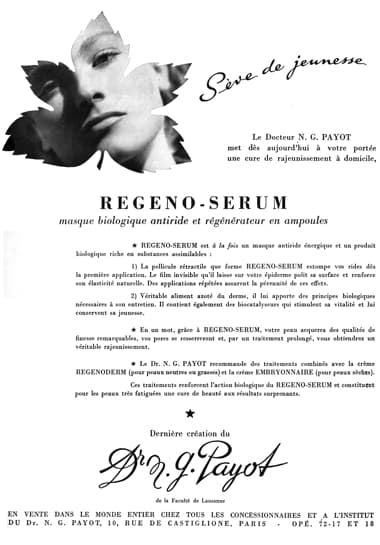
1949 Payot Regeno-serum.
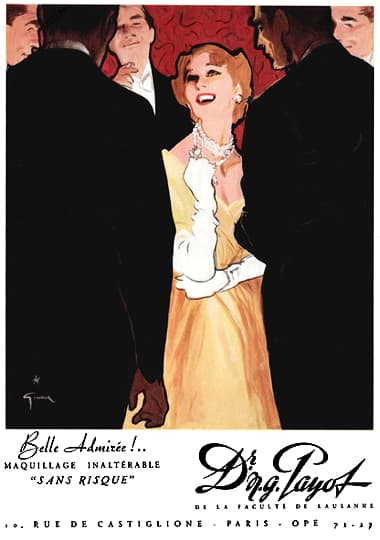
1949 Payot Sans Risque.
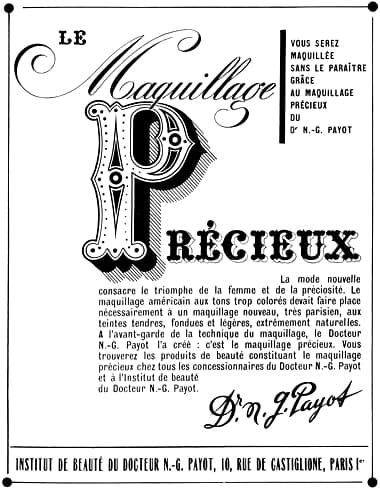
1949 Payot Precieux, one of a number of coordinated make-up introduced after the war in response to American firms like Revlon.
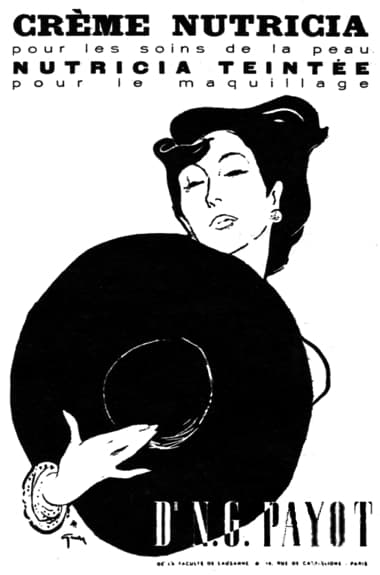
1950 Payot Crème Nutricia Tintée.
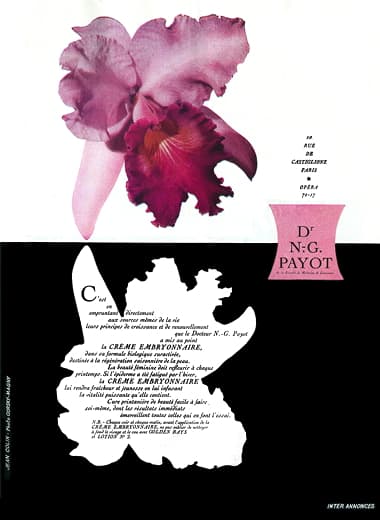
1951 Payot Crème Embryonnaire.
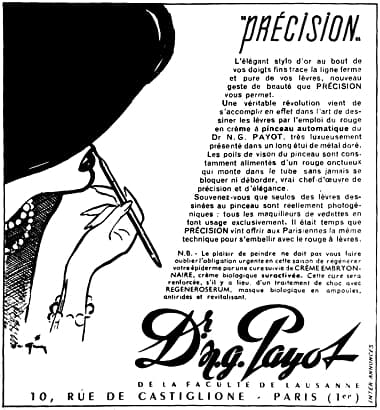
1951 Payot Précision combination lipstick and lipliner.
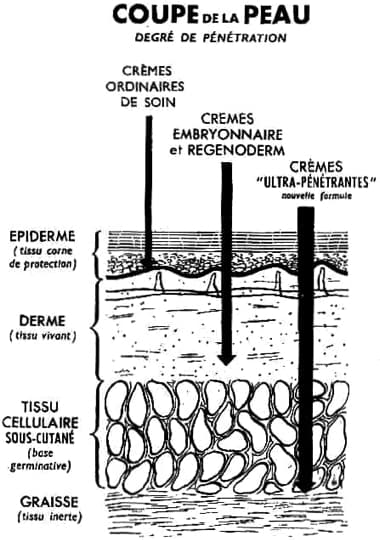
c.1954 Payot Ultra-Pénétrante Crèmes.
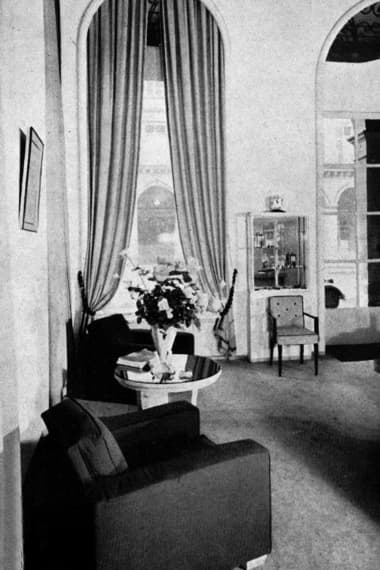
1955 Reception room at 10 Rue de Castiglione.
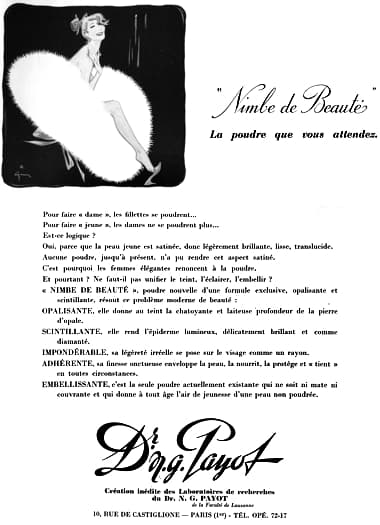
1956 Payot Nimbe de Beauté Poudre.
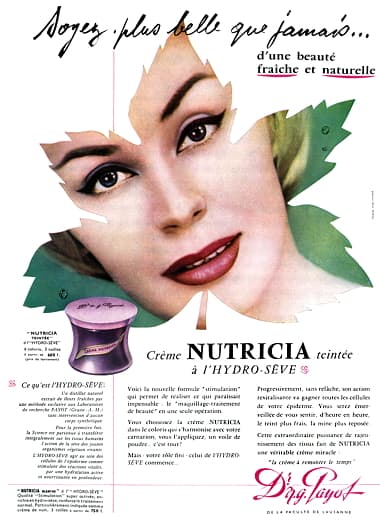
1957 Payot Crème Nutricia Tientée à l’Hydro-Sève.
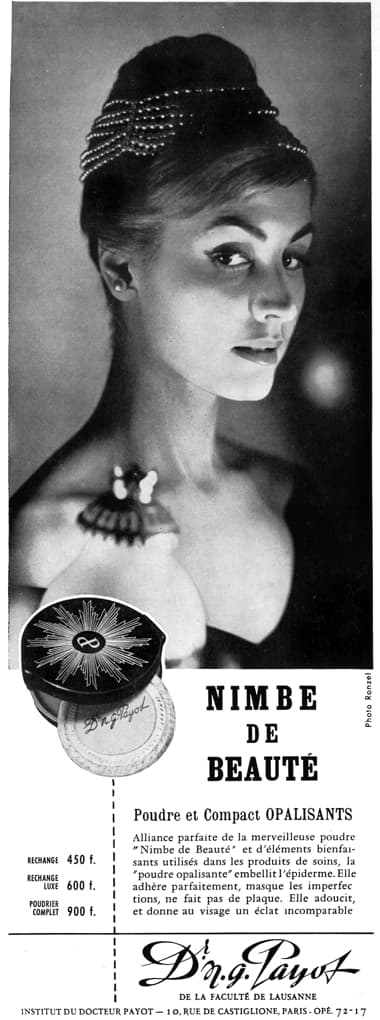
1958 Payot Nimbe de Beauté Poudre and Compact.
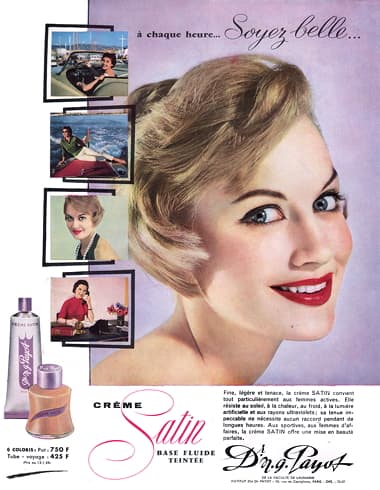
1958 Payot Satin.
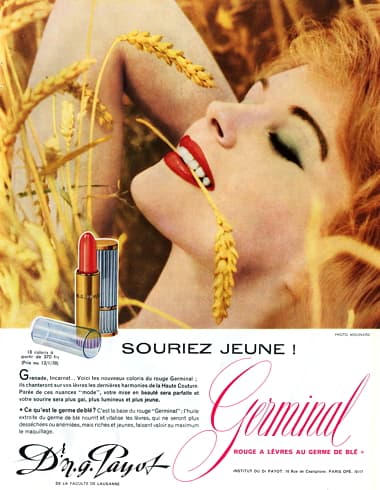
1958 Payot Germinal Lipstick.
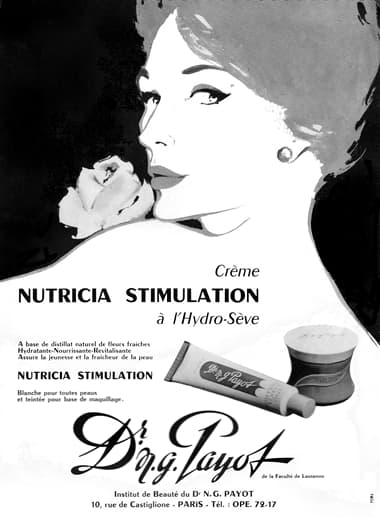
1960 Payot Crème Nutricia Stimulation.
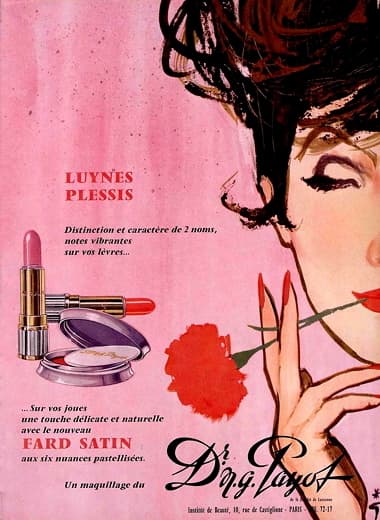
1960 Payot Fard Satin.
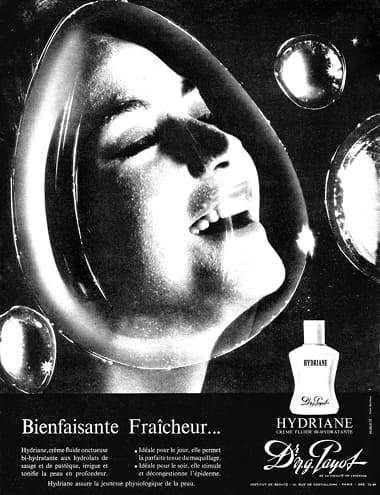
1961 Payot Hydriane
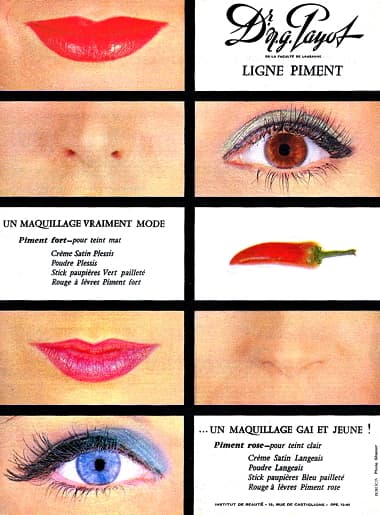
1961 Payot Ligne Piment.
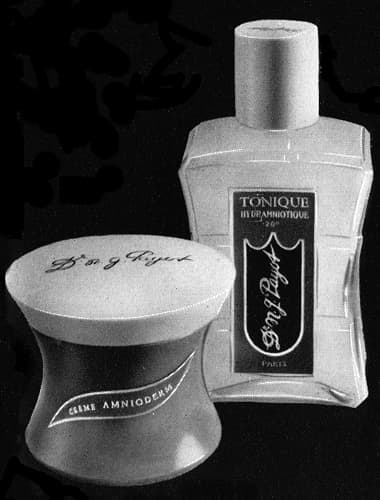
Crème Amnioderm and Tonique Hydramniotique.
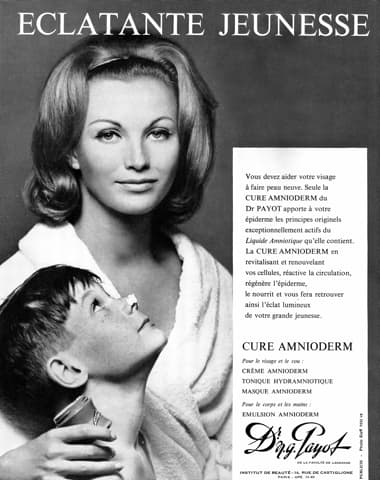
1962 Payot Cure Amnioderm: Crème Amnioderm, Tonique Hydramniotique, Masque Amnioderm and Emulsion Amnioderm.
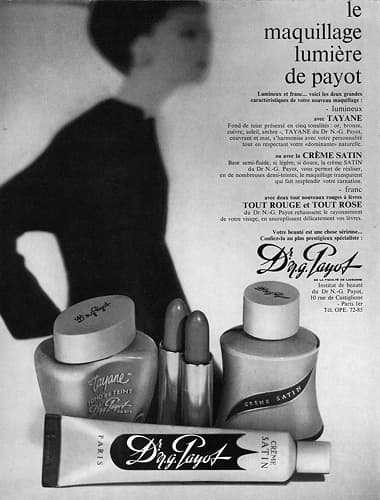
1962 Payot Tayane, Lipstick and Crème Satin.
